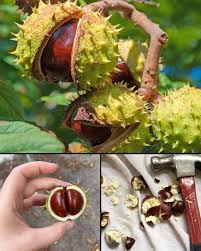The horse chestnut tree (Aesculus hippocastanum) is an extraordinary natural resource, celebrated for its diverse applications in traditional medicine and handmade soap crafting. This guide will walk you through the practical ways to unlock the potential of horse chestnuts for both medicinal and creative purposes, offering detailed steps to make the most of this remarkable tree.
Medicinal Uses of Horse Chestnut
For centuries, horse chestnut seeds and bark have been prized for their therapeutic properties. Here’s how you can prepare and use them effectively:
1. Crafting Horse Chestnut Extract
a. Harvesting Seeds:
Collect fresh horse chestnuts during the fall when their spiky green pods naturally split open, revealing the glossy brown seeds inside.
b. Dehusking:
Carefully remove the hard outer shell to access the seed. Note: Horse chestnuts contain toxic compounds, so proper preparation is critical.
c. Slicing and Drying:
Cut the seeds into small pieces and allow them to dry in a cool, dry place or use a dehydrator for faster results.
d. Infusing in Oil:
Combine the dried pieces with a carrier oil like olive or coconut oil (1 part seeds to 5 parts oil). Place the mixture in a sealed glass jar and let it infuse for 6–8 weeks in a dark, cool location, shaking it gently every few days.
e. Straining and Storing:
After infusion, strain the oil to remove solids and store it in a dark glass bottle with a tight lid. This extract can be applied topically to help with varicose veins, hemorrhoids, and minor skin issues.
2. Making Horse Chestnut Ointments
a. Ingredients:
You’ll need horse chestnut oil extract, beeswax, and optional essential oils like lavender or chamomile for added benefits.
b. Melting and Mixing:
In a double boiler, gently heat 4 parts horse chestnut oil extract with 1 part beeswax until fully melted and combined.
c. Adding Essential Oils (Optional):
Stir in a few drops of essential oils for fragrance and additional soothing properties.
d. Pouring and Cooling:
Transfer the mixture into small containers and let it cool to solidify.
e. Application and Storage:
Store the ointment in a cool, dark place. Apply it to areas affected by varicose veins, bruises, or sprains for relief.

Horse Chestnut in Soap Making
Adding horse chestnut to homemade soap creates a unique skincare product with gentle cleansing and nourishing benefits.
Ingredients Needed:
- Horse chestnut extract or oil
- Lye (sodium hydroxide)
- Water
- Oils/fats (e.g., coconut oil, olive oil, palm oil)
- Optional: Essential oils for fragrance
Safety First:
When handling lye, always wear gloves, goggles, and work in a well-ventilated space.
Step-by-Step Process
1. Prepare Lye Solution:
Dissolve lye in water, being cautious of heat and fumes. Allow it to cool before use.
2. Heat Oils:
Melt your chosen oils and fats in a large pot, then let them cool to the appropriate temperature.
3. Combine and Mix:
Slowly pour the lye solution into the melted oils while stirring continuously until emulsified.
4. Add Horse Chestnut Extract:
Incorporate 1–2 tablespoons of horse chestnut extract per pound of oils. Adjust based on your preferences.
5. Optional Fragrance:
Add essential oils for fragrance.
6. Pour and Set:
Pour the mixture into molds, let it harden overnight, and cure the soap for several weeks for optimal texture.
7. Enjoy:
Use your horse chestnut soap for its skin-soothing properties during your daily care routine.
Important Disclaimer
This article is for informational purposes only. Always consult a qualified healthcare provider before using natural remedies, particularly if you have underlying conditions, are pregnant, or are taking medications. Proper preparation of horse chestnuts is essential, as some parts of the plant contain toxic compounds.
When crafting soaps or ointments, follow safety guidelines, especially when handling ingredients like lye. Protect your health by using the information responsibly and consulting experts as needed.
The horse chestnut tree offers a world of possibilities for health and creativity. By following these detailed steps, you can explore its therapeutic and practical applications while enjoying the satisfaction of crafting your own remedies and skincare products.
